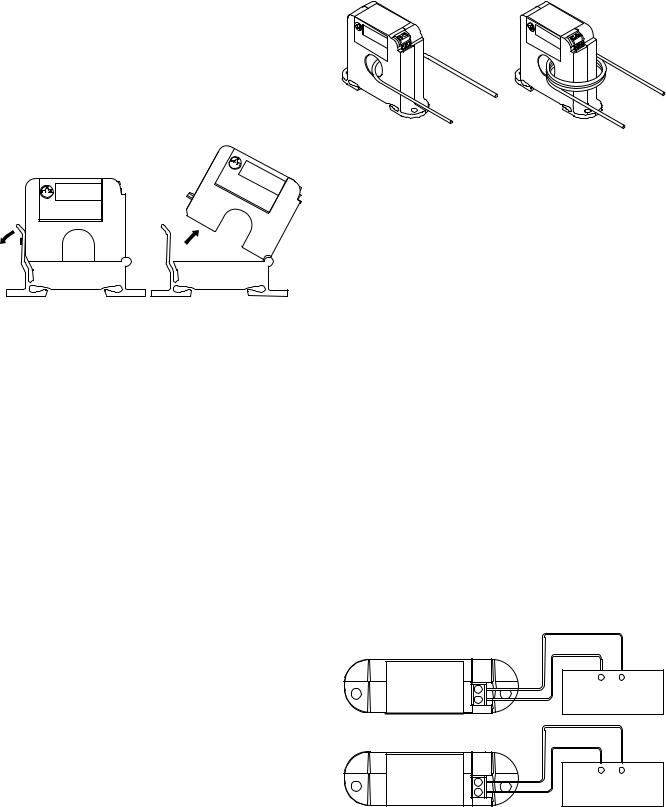Honeywell CP SERIES, CS SERIES Installation Instructions

Current Switches - Solid and Split
Core
CPAND CSSERIES
INSTALLATION INSTRUCTIONS
APPLICATION
The CSand CPcurrent switches are designed for use in any AC current monitoring application in which you are looking to monitor a particular piece of equipment.
SPECIFICATIONS
Monitored Current Type: AC Current
Maximum AC Voltage: 600 VAC
Isolation Voltage: 2200 VAC
Supply Voltage:
+8.5 to 30 VDC (Reverse Polarity Protected) 250 Ohm Load (1-5 VDC): +13.5 to 30 VDC 500 Ohm Load (2-10 VDC): +18.5 to 30 VDC
Operating Temperature Range: 5 to 104ºF (-15 to 40ºC)
Operating Humidity Range: 0 to 95%, non-condensing
Wire Recommendations: 2 Conductor (Shielded Cable)
Wire Size:
18 to 24 AWG (0.823 mm2 to 0.205 mm) Copper Wires only
Terminal Block Torque Rating: 4.43 to 5.31 in-lbs. (0.5 to 0.6 Nm)
Minimum Mounting Distance:
1” (2.6 cm) between current sensor & other magnetic devices (Relays, Contactors, Transformers)
Agency Approvals:
CE (-RMS Versions): CE to IEC 61326-1: 2012 Class A, UL/CUL US Listed (UL 508) Ind. Control Equipment (File # E309723), RoHS2, WEEE
PLEASE READ INSTRUCTIONS CAREFULLY BEFORE INSTALLATION!
 WARNING
WARNING
Electrical Shock Hazard
Disconnect and lock out all power sources before installation as severe injury or death may result from electrical shock due to contact with high voltage wires. Never rely on the LEDs to determine whether power is present at the current switch. At very low monitored input currents the LEDs may not light.
INSTALLATION
Make sure that all installations are in compliance with all national and local electrical codes. Only qualified individuals that are familiar with codes, standards, and proper safety procedures for high-voltage installations should attempt installation. The current switches will not require external power, since the power for the current switch is induced from the conductor being monitored.
The current switch may be mounted in any position using the two #8 x 3/4” Tek screws and the mounting holes in the base, or snapped directly on to the 35mm DIN rail (See Fig. 1). Leave a minimum distance of 1” (3 cm) between the current switch and any other magnetic devices such as contactors and transformers.
M37378
 WARNING
WARNING
This product is not intended to be used for Life or Safety applications.
This product is not intended for use in any hazardous or classified locations.
The Current Switches must be used on Insulated Conductors Only!
Fig. 1. Sensor Placed On Rail.
Latch Operation for Split Core Models
Press down on the side tab and swing the top of the unit up to open the split core current switch as shown in Fig. 2. Press down firmly on the cover to close the current switch. An audible “click” will be heard as the tab slides over the tongue on the base.
 20
20

31-00146-02

CURRENT SWITCHES - SOLID AND SPLIT CORE
 CAUTION
CAUTION
Mating surfaces of the magnetic core are exposed when the sensor is open.
Electrical contact grease, present on the cores to prevent corrosion, can capture grit and dirt if care is not exercised. Operation can be impaired if anything prevents good contact between pole pieces. Visually check the mating parts of the core before closing the current sensor.
M37379
Fig. 2. Opening Split Core Models.
LEDs
Fixed Trip Point Models
The Red LED will indicate whether the current is above (LED On) or below (LED Off) the fixed trip point. At very low monitored input currents the Red LED may not light to indicate the current is above the trip point.
Adjustable Trip Point Models
The Red LED will indicate whether the current is above the adjustable trip point. The Blue LED will indicate whether the current is below the adjustable trip point. At very low monitored input currents the LEDs may not light.
Application Notes
The conductor being monitored may be looped through the sensor multiple times. The loops increase the current measured by the current switch. Each time the conductor passes through the current switch window equals one loop. (See Fig. 3). To determine the proper number of loops required, take the rated Fixed Trip Point or Minimum Adjustable Trip Point (see Table 2) of the current switch and divide it by the Operating Current of the Monitored Device, add one (1), then round up to the nearest whole number. Example: When using the CS-O-A, a small fan operating at 0.17A should be wrapped through the sensor four times to give you a total operating current of 0.68 Amps flowing through the CS-O-A. Formula Example: (0.5A/0.17A) = 2.94 + 1 = 3.94, which rounded up equals 4 loops.
M37380
Fig. 3. Wires Through Sensors
WIRING
We recommend the use of a two conductor 16 to 22 AWG shielded cable or twisted pair copper wire only, for all current switch applications. A maximum wire length of less than 30 meters (98.4 feet) should be used between the current switch and the Building Management System or controller.
NOTE: When using a shielded cable, be sure to connect only (1) end of the shield to ground at the controller. Connecting both ends of the shield to ground may cause a ground loop.
When removing the shield from the sensor end, make sure to properly trim the shield to prevent any chance of shorting. The current switch output terminals represent a solid-state switch for controlling both AC and DC loads and are not polarity sensitive. Tighten the screws at the terminal block connections to the recommended torque of 0.5 to 0.6 Nm (4.43 to 5.31 in-lbs.). The aperture (hole) size of the current switch is 0.75” (1.90 cm).
Application Examples
See Fig. 4 and Fig. 5 for two different current switch applications using your Building Management System (DDC/PLC Controller). Fig. 4 is showing the use of the Current Switch as a Digital Input to your DDC Controller, whereas Fig. 5 is showing you how to use the Current Switch in conjunction with your building management system to monitor belt loss on a motor.
DIGITAL INPUT #1
CONTROLLER
M37381
DIGITAL INPUT #1
CONTROLLER
M37382
Fig. 4. Digital Circuit
31-00146—02 |
2 |
